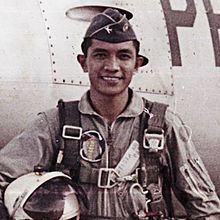Nickname(s) Tony, Bote Name Antonio Bautista | Rank Lieutenant Colonel Years of service 1958-1974 | |
 | ||
Commands held 9th Tactical Fighter Squadron, 5th Fighter WingCommander, Joint 7th and 9th Fighter Squadron, SATAG Battles/wars Philippine Insurgency Wars of the 70's Awards Distinguished Conduct Star (1)Gold Cross of Gallantry (2)Military Merit Medal (7)Silver Wing Medal (2)Distinguished Aviation Cross (2)Military Commendation Medal (1) Died January 11, 1974, Jolo, Philippines | ||
Antonio bautista guzman
Antonio M. Bautista (September 17, 1937– January 11, 1974) was an F-86 Sabre pilot who served in the Philippine Air Force. He served in the acrobatic display team the Blue Diamonds and fought against rebels in the south of the country. He was killed in action in January 1974.
Contents
- Antonio bautista guzman
- U s philippine armed forces load onto c 130 at antonio bautista air base philippines
- Biography
- References

U s philippine armed forces load onto c 130 at antonio bautista air base philippines
Biography
Lieutenant Colonel Antonio "Tony" Marfori Bautista (serial no 0-4457) was a combat pilot of the Philippine Air Force (PAF). Tony Bautista was a former aviation cadet of PAF-FS Class of 1958. He fought against the 1970s insurgency in the south of the Philippines. He was a member of the Blue Diamonds Aerial demonstration Team from 1964 to 1966 (with the 6th Tactical Fighter Squadron), the team leader of the 9th Tactical Fighter Squadron Aerobatic team "Golden Sabres" in 1972, and the team leader of the "Sabres", the combined 7th TFS "Red Aces" and 9th TFS "Golden Sabres" aerobatic teams in 1973.
Antonio Bautista graduated from The University of the Philippines Los Baños in 1957 with a degree in Agriculture. He joined the Air Force by signing up with the Philippine Air Force Flying School in Fernando Air Base, Lipa, Batangas. After graduating in 1958, Bautista was sent to the 5th Fighter Wing stationed at Basa Air Base, Floridablanca, Pampanga. His first Assignment was with the 8th Fighter Squadron, Nicknamed "Scorpions", flying piston driven North American F-51 Mustangs. At about the same time the PhilAF was in the process of transitioning to Jets, so in 1959 in preparation for Jet Training he was sent to Kadena Air Force Base in Okinawa, Japan, for Altitude Physiological Training. In 1961 to 1962, he was assigned to the USAF to take the Jet Qualification Course at Randolph Air Force Base, San Antonio, Texas. In 1962 he continued his training at Luke Air Force Base, Arizona, for aerial gunnery and combat training.
When Bautista returned from the overseas training he was sent back to Basa Air Base but reassigned to the 6th Tactical Fighter Squadron flying the North American F-86 Sabre. In 1971, he assumed command of the 9th Tactical Fighter "Limbas" Squadron. His last assignment was Commander of the joint 7th and 9th Tactical Fighter Squadrons of the Sulu Air Task Group (SATAG) forward deployed in Edwin Andrews Air Base, Zamboanga, for Counter-insurgency (COIN) operations against insurgent separatists in Mindanao.
Antonio Bautista is the only airman known to have served with all five fighter squadrons in the Philippine Air Force 5th Fighter Wing; the 105th, 6th TFS, 7th TFS, 8th FS and 9th TFS.
On 11 January 1974 he took off from Edwin Andrews Air Force Base, Zamboanga leading a two element flight of F-86 Sabres to support government troops that were under attack by a large number of armed rebels in Parang on Jolo Island, 200 miles away.
During the engagement he made several low attack runs, exposing himself and his aircraft to heavy rifle fire. When he finally broke off after 2 bombing runs and five strafing passes, his fighter was severely damaged; his wingman, Lt. Roger Crudo, informed him that the aircraft was on fire. He tried to divert to the nearby Jolo airstrip but his front landing gear refused to engage. Rapidly losing altitude, he bailed out at 1000 feet just before his plane exploded in mid-air. He planned to eject over government controlled territory but unfortunately his parachute drifted back over enemy lines. Rescue Helicopters led by Colonel Luis Diano were forced to land 1 kilometer away from him due to severe hostile fire. Despite the rescue attempts and efforts by Bautista to defend his position using his service pistol, he was overrun by moro rebels and killed before rescue forces could reach him.
Philippine Air Force Tsgt Nonito Calizo (serial nos 547945) and Airman Benjamin Lojo (serial nos 594257) were first to arrive on scene and secured Bautista's body. On December 12, 1975, under General Order 422, Both Calizo and Lojo were Awarded the Gold Cross for braving the line of fire in the process of retrieving the body of Lt Col Bautista.
For his uncommon bravery and tenacity in the face of overwhelming odds, the Armed Forces of the Philippines under General Order 519, posthumously awarded Bautista the Distinguished Conduct Star on April 29, 1974. His widow, Alice Jane Rigor received the awards on behalf of her husband from then Philippine President, Ferdinand Marcos. For his gallantry, the PAF airbase at Puerto Princesa, Palawan (island) was named Antonio Bautista Air Base in his honor when it opened on 21 March 1975. It is now home to the Air Force's 570th Composite Tactical Wing.
